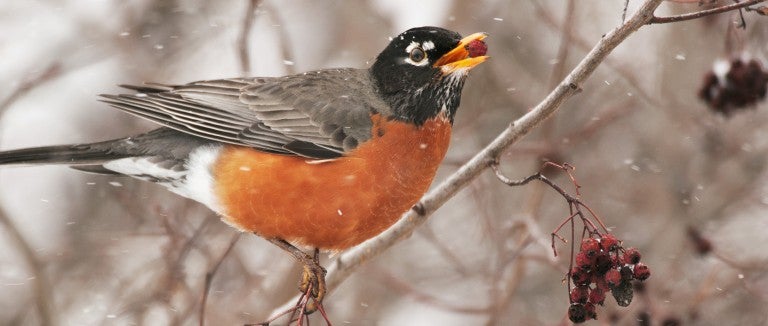As monarch butterflies and hummingbirds headed south this fall, I dreamt of following my favorite snowbirds to Mexico and Central America. But I stayed home instead, where I have a window onto the spectacular world of winter wildlife: northern flickers tossing maple leaves with their beaks in search of frozen beetle treats, mockingbirds guarding snow-ripened fruit on winterberry hollies, squirrels standing up to nibble flower seeds, deer browsing sumac sprouts I leave just for them.
There wasn’t always so much cold-weather action. But one year as I watched sparrows feast on switchgrass seeds in an otherwise bleak landscape, it dawned on me: Animals need plants in all stages—live and dead, green and brown, upright and fallen—all year. What we do (or don’t do) outside affects whether they live to see another spring. This winter, use this checklist to cultivate a year-round home for your wild neighbors.
Do you have leafy blankets?
Too often, leaf blowers and rakes destroy winter habitat, where bumblebees, hummingbird moths, fritillary caterpillars and toads seek shelter. Many insects and amphibians, including wood frogs, produce antifreeze substances to survive the cold, but they also need protective layers of decaying plants. Leaving leaves around trees, shrubs and perennials provides winter refuge for them, a snack bar for foraging birds, and even nesting sites for rabbits in spring.
A humane backyard is a natural habitat offering wildlife plenty of food, water and cover, plus a safe place to live free from pesticides, chemicals, free-roaming pets, inhumane practices and other threats. And it's so easy to build!

Do you leave stalks for insect nurseries?
Look inside a seedpod, and you may find an Eastern-tailed blue butterfly larva, notes naturalist Mary Anne Borge, creator of The Natural Web. “One time I saw a spider nest in an empty beechnut husk that was still clinging to a tree,” she says. “Everything gets reused. It’s a place to hang out, it’s a place to survive.” Stalks and stems harbor bee larvae inside and chrysalises on the surface; Borge once found a promethea moth cocoon wrapped tightly around a spicebush branch and returned in spring to watch it hatch.
Do you furnish your garden with decaying wood?
Line beds with logs and rocks to protect terrestrial salamanders, lizards and beetles. Let eye-catching fungi overtake stumps, where woolly bear caterpillars disappear into the crevices. Plant shagbark hickory and other trees with peeling bark to shelter mourning cloak butterflies; build brush piles for birds, raccoons, foxes and moths like the American dagger, who cocoons in rotting wood. Let native shrubs and trees spread for hungry browsers.
Many of our wild residents can’t fly south as temperatures dip. What they really need is an abundance of plants—and the courage on our part to let those plants sprout, flourish and decompose naturally into permanent, lifelong homes.
Want more content like this?
This was written and produced by the team behind All Animals, our award-winning magazine. Each issue is packed with inspiring stories about how we are changing the world for animals together.
Learn MoreSubscribe

